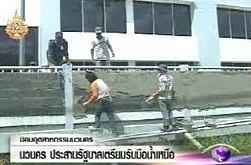BANGKOK, June 5 – Thailand’s Cabinet has approved a Bt6 billion budget for building flood-protection dykes at six industrial estates while giving a green light to prepare 2.1 million rai of land for flood retention areas with a 5.1 billion cubic metre capacity, according to Minister of Science and Technology Plodprasop Suraswadi.
Mr Plodprasop said that the Cabinet at its weekly meeting approved a budget of more than Bt6 billion to build at six key industrial estates.

The government will cover the two-thirds of the total cost of construction, he said, adding that the dykes would help prevent floods in future. He assured some 200,000 workers that they would not suffer the extensive flood-induced dislocations and economic losses as last year.
Construction is expected to take less than two months to complete, the minister said.
The six industrial estates are Bang Pa-in, Bangkadi, Rojana, Hi-Tech, Nava Nakorn and Saha Rattana Nakhon.
Seven industrial estates and parks were hard hit by massive floods last year, five in Ayutthaya — Saha Rattana Nakhon, Bang Pa-in, Rojana, Hi-Tech and Factory Land; two in Pathum Thani — Bangkadi and Nava Nakorn, all of which were forced to close due to deep floodwaters.
Mr Plodprasop said that the Cabinet also approved a plan for flood retention areas of 2.1 million rai with a 5.1 billion cubic metre storage capacity.
About 900,000 rai of land would be an area under the jurisdiction of the Royal Irrigation Department (RID) while another 1.2 million rai would be the responsibility of other agencies, he said.
Some Bt3.9 billion will be spent on preparations and the mechanism to control the flow of water.
Prime Minister Yingluck Shinawatra will soon inspect the progress of the flood-prevention projects at the lower part of northern region and upper central region, according to the minister.
Mr Plodprasop said he is confident that this year’s floods would not be as severe as last year’s, but in the worst case, residents may have to walk through floodwaters that don’t last very long.




